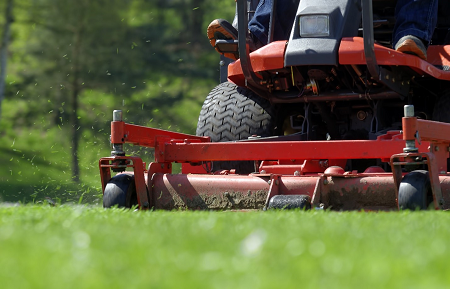
The Consumer Product Safety Commission estimates that 35,000 injuries and nearly 100 deaths related to riding lawnmowers occur each year in the U.S. These accidents are mostly due to loss of stability and operators thrown from or falling under the equipment. With proper employee training, these injuries and deaths are preventable.
1 Use a rollover protective structure (RPS) and a seat belt.
Equip riding lawnmowers with an RPS, or rollbar, and a seat belt to prevent injuries. Contact the manufacturer for a kit for any riding lawnmower without rollover protection or a seat belt.
2 Equip lawnmowers with an operator presence control (OPC) system.
An OPC system is a safety device that stops the rotary blade when the lawnmower operator rises out of the seat to perform a task or is thrown from the lawnmower. This feature reduces the chances of lacerations, amputations, and death.3 Inspect lawnmowers before each use.
Use a checklist to inspect the lawnmower before each use. Look for any missing or damaged guards, loose belts, out-of-balance blades, or fluid leaks.
4 Wear personal protective equipment.
Wear steel-toed, non-slip safety boots and tight-fitting clothes to avoid fabric getting caught in the lawnmower’s moving parts. Employers should provide safety glasses, hearing protection, and bump caps or hardhats at no cost to the employee.
5 Prepare the mowing area.
Debris picked up by a lawnmower can be thrown from the machine at speeds up to 200 miles per hour. Walk the mowing path and remove dangers, such as large rocks, fallen branches, discarded construction materials, or other hazards that may be hidden in tall grass.
6 Start the lawnmower from the driver’s seat.
Never place the mower in motion until the driver is ready and belted in the seat. Never leave a running lawnmower unattended.
7 Stay away from unprotected drop-offs and water hazards.
Never operate riding lawnmowers in areas where the machine’s wheels are within five feet of an unprotected ledge, such as retaining walls, ditches, or other locations that present rollover hazards. Keep a safe distance from bodies of water, such as ponds, creeks, lakes, and golf course water hazards. The width of two mowers is often adequate.
8 Use extra caution on slopes.
Never operate riding lawnmowers on slopes that exceed the manufacturer’s angle limits. Mow up and down rather than across on slopes to avoid rollovers. Keep all movements on slopes slow and gradual. If a turn must be made on a slope, turn downhill slowly with the lawnmower’s heavy end uphill.
9 Never carry passengers.
Riding lawnmowers are one-person machines.
10 Keep hands and feet away from rotating mower parts.
Never reach around or beneath a running mower or put a foot on the ground to attempt to stabilize the machine. Hands and feet can get pulled into the blade. Shut off the engine before removing debris.
Download DWC’s Riding Lawnmower Safety Fact Sheet (English/Spanish) for more information or contact a DWC Safety Training Specialist for customized landscaping, lawn care, and mower safety training at safetytraining@tdi.texas.gov or 1-800-252-7031, option 2.
